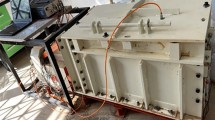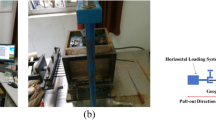Abstract
This study presents the results of geogrid pullout tests conducted in wet and fine-grained soils. Failures of reinforced soil structures have often involved inadequate drainage due to the use of fine-grained soils, which has led to stringent specifications for backfill material in such structures although there are significant economic reasons for relieving the specifications. One approach to improve the issue is to reinforce fine-grained soils with geosynthetic providing both reinforcement and lateral drainage. Although using reinforcement with in-plane drainage capability is conceptually promising, transmissivity requirements for this application have not been properly evaluated. Pullout tests were conducted on cohesive soils using geogrids with the same tensile strength but with and without in-plane drainage channels. The results indicate that geogrids with in-plane drainage layers show higher pullout resistance than conventional geogrids. The finding contributes to promoting the use of poorly draining soils as backfill material.
Similar content being viewed by others
References
Benjamim, C. V. S., Bueno, B. S., and Zornberg J. G. (2007). “Field monitoring evaluation of geotextile-reinforced soil-retaining walls.” Geosynthetics International, Vol. 14, No. 2, pp. 100–118.
Bergado, D. T., Long, P. V., Lee, C. H., Loke, K. H., and Werner, G. (1994). “Performance of reinforced embankment on soft Bangkok clay with highstrength geotextile reinforcement.” Geotextiles and Geomembranes, Vol. 13, Nos. 6–7, pp. 403–420.
Bergado, D. T., Long, P. V., and Srinivasa Murthy, B. R. (2002). “A case study of geotextile-reinforced embankment on soft ground.” Geotextiles and Geomembranes, Vol. 20, No. 6, pp. 343–365.
Christopher, B. R. and Berg, R. R. (1990). “Pullout evaluation of geosynthetics in cohesive soils.” Proceedings of the Fourth International Conference on Geotextiles, Geomembranes and Related Products, The Hague, Vol. 2, Netherlands, pp. 731–736.
Elias, V. and Swanson, P. (1983). “Cautions of reinforced earth with residual soils.” Transportation Research Record, Vol. 919, pp. 21–26.
Helwany, S. M. B., Reardon, G., and Wu, J. T. H. (1999). “Effects of backfill on the performance of GRS retaining walls.” Geotextiles and Geomembranes, Vol. 17, No. 1, pp. 1–16.
Jewell, R. A. and Jones, C. J. (1981). “Reinforcement of clay soils and waste materials using grids.” Proceedings of the Tenth International Conference on Soil Mechanics and Foundation Engineering, Balkema, Vol. 2, Stockholm, Sweden, pp. 701–706.
Mitchell, J. K. (1991). “Conduction phenomena: From theory togeotechnical practice.” Géotechnique, Vol. 41, No. 3, pp. 299–340.
Mitchell, J. K. and Zornberg, J. G. (1994). “Reinforced soil structures with poorly draining backfills. Part II: Case histories and applications.” Geosynthetic International, Vol. 2, No. 1, pp. 265–307.
Porbaha, A. (1996). “Geotextile reinforced lime treated cohesive soil retaining walls.” Geosynthetics International, Vol. 3, No. 3, pp. 227–268.
Porbaha, A. and Goodings, D. J. (1996). “Centrifuge modeling of geotextilereinforced cohesive soil retaining walls.” Journal of Geotechnical Engineering.
Tan, S. A., Chew, S. H, Ng, C. C., Loh, S. L., Karunaratne, G. P., and Loke, K. H. (2001). “Large-scale drainage behavior of composite geotextile and geogrid in residual soil.” Geotextiles and Geomembranes, Vol. 19, Issue 3, pp. 163–176.
Terram Geosynthetics Ltd. (2001). Paragrid and Paradrain for Soil Reinforcement, www.terram.co.uk
Yamauchi, H., Tatsuoka, F., Nakamura, K., and Iwasaki, K. (1987). “Stability of steep clay embankments reinforced with a non-woven geotextile.” Proceedings of the Post Vienna Conference on Geotextiles, Singapore, pp. 370–386.
Zeynep, D. and Tezcan, S. (1992). “Cost analysis of reinforced soil walls.” Geotextiles and Geomembranes, Vol. 11, No. 1, pp. 29–4382.
Zornberg, J. G. and Mitchell, J. K. (1994). “Reinforced soil structures with poorly draining backfills. Part I: Reinforcement interactions and functions.” Geosynthetic International, Vol. 1, No. 2, pp. 103–148.
Author information
Authors and Affiliations
Corresponding author
Rights and permissions
About this article
Cite this article
Kang, Y., Nam, B., Zornberg, J.G. et al. Pullout resistance of geogrid reinforcement with in-plane drainage capacity in cohesive soil. KSCE J Civ Eng 19, 602–610 (2015). https://doi.org/10.1007/s12205-013-0274-4
Received:
Revised:
Accepted:
Published:
Issue Date:
DOI: https://doi.org/10.1007/s12205-013-0274-4




